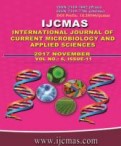


 National Academy of Agricultural Sciences (NAAS)
National Academy of Agricultural Sciences (NAAS)

|
PRINT ISSN : 2319-7692
Online ISSN : 2319-7706 Issues : 12 per year Publisher : Excellent Publishers Email : editorijcmas@gmail.com / submit@ijcmas.com Editor-in-chief: Dr.M.Prakash Index Copernicus ICV 2018: 95.39 NAAS RATING 2020: 5.38 |
The studies conducted on mode of perpetuation of sheath blight pathogen (Thanatephorus cucumeris) of rice (Oryza sativa L.) in/on rice seeds, plant debris and through sclerotia was studied at different placement conditions viz., on soil surface, at 5 cm soil depth and in-door under roof cover after crop harvest. The rice seeds were found to harbour externally viable pathogen up to five months from the harvest. The pathogen survived the crop less off-season as mycelium in infected straw and as sclerotia when placed either on soil surface, or 5 cm deep in soil or in-doors under roof cover. However, the viability decreased at all the placements with increase in storage period. After seven months, the maximum straw bits (68.66%) harboured viable T. cucumeris when placed in-doors under roof cover followed by placement at 5 cm soil depth (45.50%) and on soil surface (34.33%). In case of sclerotia, maximum viable sclerotia (91.04%) were found in-doors under roof cover, followed by placement at 5 cm soil depth (74.71%) and on soil surface (64.66%).
 |
 |
 |
 |
 |